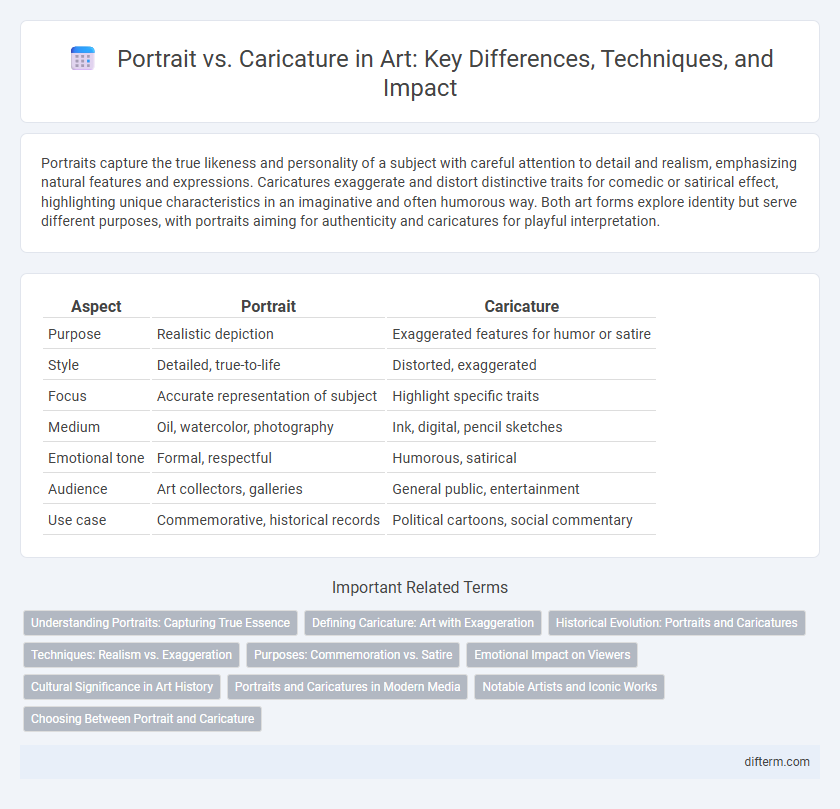Portraits capture the true likeness and personality of a subject with careful attention to detail and realism, emphasizing natural features and expressions. Caricatures exaggerate and distort distinctive traits for comedic or satirical effect, highlighting unique characteristics in an imaginative and often humorous way. Both art forms explore identity but serve different purposes, with portraits aiming for authenticity and caricatures for playful interpretation.
Table of Comparison
| Aspect | Portrait | Caricature |
|---|---|---|
| Purpose | Realistic depiction | Exaggerated features for humor or satire |
| Style | Detailed, true-to-life | Distorted, exaggerated |
| Focus | Accurate representation of subject | Highlight specific traits |
| Medium | Oil, watercolor, photography | Ink, digital, pencil sketches |
| Emotional tone | Formal, respectful | Humorous, satirical |
| Audience | Art collectors, galleries | General public, entertainment |
| Use case | Commemorative, historical records | Political cartoons, social commentary |
Understanding Portraits: Capturing True Essence
Portraits aim to capture the true essence of a subject by emphasizing realistic details and emotional depth, presenting an authentic representation of personality and character. Unlike caricatures, which exaggerate features for comedic or satirical effect, portraits rely on precise anatomy, light, and shadow to convey genuine identity and mood. Mastery in portrait art requires keen observation and technical skill to reveal the sitter's inner qualities beyond mere physical appearance.
Defining Caricature: Art with Exaggeration
Caricature is a distinct art form that exaggerates prominent facial features or characteristics to create a humorous or satirical effect. Unlike portraits, which aim for realistic and accurate representation, caricatures emphasize distortion to highlight personality traits or social commentary. This method relies on artistic skill to capture the essence of the subject while amplifying specific elements for visual impact.
Historical Evolution: Portraits and Caricatures
Portraits have evolved from rigid, formal depictions in the Renaissance, emphasizing realism and nobility, to diverse expressions reflecting personal identity and social status. Caricatures emerged prominently in the 18th century as exaggerated, satirical representations, often used in political commentary and social critique. Both forms highlight shifting cultural values and technological advances in art reproduction throughout history.
Techniques: Realism vs. Exaggeration
Portrait techniques emphasize realism, capturing accurate facial features, skin tones, and expressions to convey the subject's true appearance. Caricature techniques rely on exaggeration, distorting distinctive features such as enlarged noses or elongated chins to highlight personality traits humorously. Realistic shading, precise proportions, and subtle details define portrait art, while caricature employs bold lines, simplified forms, and exaggerated proportions to create a playful, exaggerated effect.
Purposes: Commemoration vs. Satire
Portraits serve the purpose of commemoration by capturing the true likeness and personality of the subject, often honoring their status or achievements. Caricatures emphasize satire through exaggerated features and humorous distortions, highlighting flaws or societal critiques. Both art forms use visual representation to convey distinct messages, with portraits preserving dignity and caricatures provoking reflection and laughter.
Emotional Impact on Viewers
Portraits evoke a deep emotional connection by capturing the subtle nuances of a subject's expression, allowing viewers to experience their inner essence and personality. Caricatures amplify distinct features through exaggeration, provoking a strong emotional response often linked to humor, satire, or social commentary. The emotional impact varies as portraits invite empathy and reflection, while caricatures stimulate amusement and critical engagement.
Cultural Significance in Art History
Portraits have historically served as a means to immortalize individuals, reflecting their social status, identity, and cultural values within various societies. Caricatures, by exaggerating distinctive features, offer a critical and often satirical perspective on political figures and societal norms, thus playing a pivotal role in social commentary throughout art history. Both art forms reveal evolving cultural attitudes, with portraits emphasizing reverence and caricatures highlighting humor and critique.
Portraits and Caricatures in Modern Media
Portraits in modern media emphasize realistic representation, capturing the nuanced expressions and personality of the subject with detailed brushwork or high-resolution photography. Caricatures exaggerate distinctive features, using humor and satire to convey social commentary or entertainment value, often seen in editorial cartoons and digital illustrations. Both forms play vital roles in visual storytelling, influencing public perception through different artistic techniques and narrative purposes.
Notable Artists and Iconic Works
Notable artists like Chuck Close revolutionized portraiture with hyper-realistic paintings emphasizing detail and texture, while caricature masters such as Al Hirschfeld gained fame for exaggerated yet recognizable depictions of celebrities. Iconic works include Close's large-scale self-portraits, which capture intricate facial features with photographic precision, and Hirschfeld's black-and-white line drawings characterized by fluid lines and playful distortions. Both genres use distinct artistic techniques to interpret human faces, highlighting individual identity through contrasting styles.
Choosing Between Portrait and Caricature
Choosing between portrait and caricature depends on the intended emotional impact and artistic expression. Portraits capture realistic and detailed representations, emphasizing likeness and personality, while caricatures exaggerate distinctive features to convey humor or social commentary. The decision hinges on whether accuracy or exaggeration better serves the artwork's purpose and audience engagement.
portrait vs caricature Infographic

 difterm.com
difterm.com